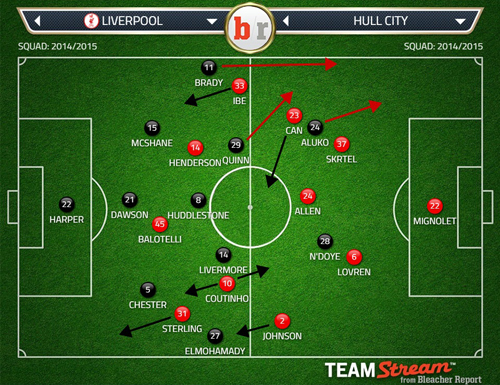By Mihail Vladimirov.
Summary:
- Hull managed to overload the space in the middle, and create a very effective block in this crucial zone.
- This created a defensive weakness out wide for the home team, but with Can again playing as a false full-back and roaming into the middle, the required dual threat of overlapping full-backs to exploit the space never materialised.
- The Tigers also showed more attacking threat than the visitors, with N’Doye and Aluko benefitting from playing 2-v-2 on the break with acres of space left down the channels.
- The space left out wide by Can was also exploited on a couple of occasions.
- Sterling and Ibe were constantly out wide, on the touchline, coupled with Balotelli dropping deep and helping the three Hull centre-backs to stay positionally disciplined, made any attacking threat posed by the away side was limited and predictable; furthermore, Henderson again failed to burst and provide the extra runner from midfield.
- Rodgers switched Can back to the more traditional full-back role in the second half, but this increased the exposure of the two centre-back by removing a man from the centre of the pitch alongside Allen.
- The in-game changes failed to impact the match because of they were largely like-for-like and didn’t offer the required movement in and around Hull’s deep, packed, defensive block.
Following their good display at Palace – which yielded them their first win in seven games – and given some key absentees, Hull remained unchanged for this game. Bruce once again kept faith with his 3-1-4-2 shape.
For Liverpool, Rodgers too kept the same team that drew blank against WBA with Allen coming in for the missing Gerrard. The shape remained the introduced at the weekend asymmetrical 4-1-2-3 with Can again asked to perform the role of the false full-back.
Hull defensively solid…
On paper any back three formation will struggle to cope with a 4-1-2-3 or 4-2-3-1 formation defensively. This is because of the easily achieved wide overload which will continually threaten to either drag the side centre-backs wider, leaving gaps for runners to exploit through the middle, or see the inside channels exploited by the wide forwards.
Here however, with Liverpool’s attacking threat so limited and their structure unable to pose that dual danger (more on this later), Hull’s 5-3-2 defensive shape proved extremely useful to deal with the opposition as the central congestion of six players created a very disciplined block. Liverpool playing with two, more often than not, hugging-the-touchline wingers and one static forward, but only one overlapping full-back, meant the side centre-backs Chester and McShane were always free to play the ‘spare man’ role and offer the required positional cover whenever needed. In addition, Quinn and especially Livermore stuck closer to Huddlestone, offering him the desired protection and helping him plug the gaps between the lines.
The rest of this post is for subscribers only.
[ttt-subscribe-article]
